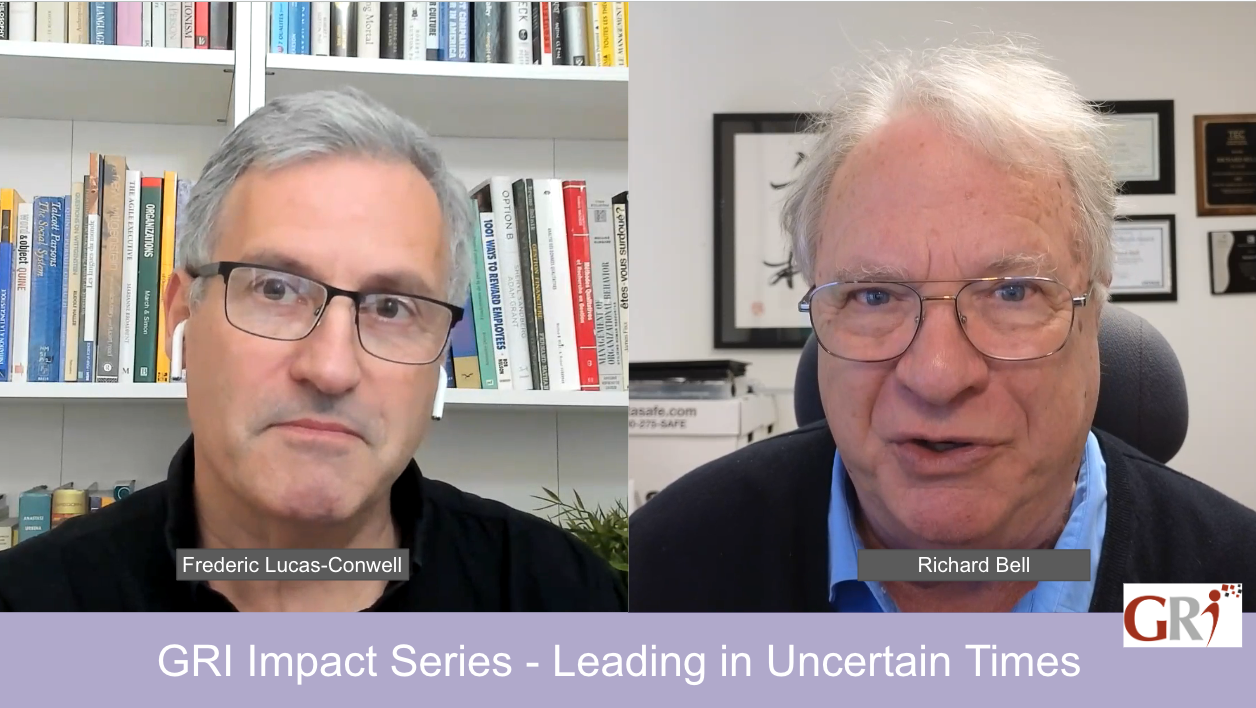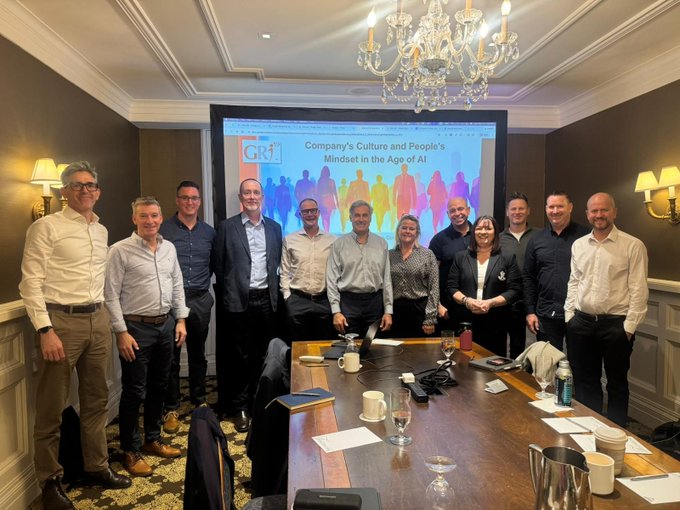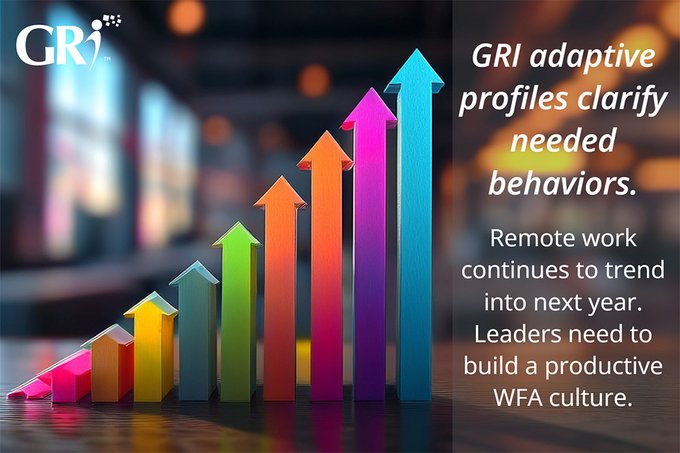Four Keys to Unlock Your Leadership in Uncertain Times
Posted by Frederic Lucas-Conwell, Richard Bell

Four Keys to Unlock Your Leadership in Uncertain Times
There is no doubt that uncertainty in business and life has ramped up over the last several years. The Covid-19 pandemic marked a traumatic period of three years, followed by a highly turbulent macroeconomic environment.
Compared to the economic uncertainty of 2008, which was intense, we now face geopolitical uncertainty. You may wonder about your factory closing in China, your client service in India, your food and energy supply delivered from far abroad, among other supply chain issues.
Post-COVID effects have also impacted our personal lives, as the boundaries between work and non-work time have blurred. Need to interrupt your dinner for a co-worker who calls for immediate assistance? Have to run a Zoom from your living room where your kid plays a video game, and your partner is working in another room? Set the alarm to speak with your biggest client in a different time zone? Those micro-stress events existed before but there was often a physical separation. Though seemingly small and sometimes positive, these events accumulate alongside more prominent, negative, and visible stressors.
Faced with an increasing number of challenges at both macro and micro levels, power skills—the modern term for people skills—become essential for leading during this time of adaptive change. Power skills encompass more than just socializing and expressing empathy; they also involve leading confidently, even when you have no idea what's going to happen tomorrow. Power skills couple self and social awareness with a capacity to adapt, inspire, and perform in a forever fast-changing and uncertain new era.
Leading Through Uncertainty
There's a whole host of new challenges for leaders that had been bubbling under the surface but are now expressed upfront in new ways.
People now ask: What's our purpose, and what are we doing for the planet? Can I work fully remotely? What's the great resignation about? What does Gen Z want? How should I approach well-being? Leaders must proactively confront and address these pressing requests for change.
Until recently, people relied on and took comfort with certain constants, such as career stability, politics, and family life. However, these factors are now actively being reevaluated, along with new considerations, as individuals continually process change, make predictions, and decide rapidly, often on the spot.
The relationship with change has evolved in terms of its variety, magnitude, and permanence. In this new context and to sustain success, leaders would do well to contemplate the following questions:
- Where might I better direct my energy and focus, given the changes that I experience? This question is crucial, as it determines the desired outcome and how to adapt. In a professional setting, this inquiry naturally leads to the next question:
- Where would each of my team members get better outcomes when they direct their energy and focus? Everyone on the team grapples with this question for similar reasons, as they each possess their own sense of purpose and belief systems. As a leader, it is vital to understand and support your team members where they currently stand.
- How can I optimally identify and promote internal talent and recruit new candidates? Our new era requires being effective at finding and upskilling the employees the organization needs, then retaining and motivating them to be successful, with yourself and the rest of the team. As a leader, these questions lead to the fourth:
- How can everyone collaborate to successfully address our shared challenges? Teamwork requires a shared understanding and language to be effective. As the leader, you are the central figure around whom others perform. It is unsurprising, then, that in times of change and uncertainty, your power skills—beyond technical expertise in areas like finance, marketing, or technology—are crucial for guiding your team through these challenges.
Your Behavior Profile and the “Budget” to Adapt
At GRI, we understand that people experience change, stress, and growth in different ways. Your behavior pattern serves as a crucial indicator of how you allocate your energy, adapt and navigate change, revealing your typical responses and behavioral adjustments to new circumstances.
Moreover, being aware of your stress responses enables you to take proactive, adaptive steps towards becoming more “responsive” to the circumstances rather than “reactive.”
The behavior-factor-based approach employed by GRI provides a practical, objective, and precise method for understanding adaptation. Each of the four behavior factors informs you about the behaviors you naturally exhibit, and the energy it takes to adapt them to different circumstances.
We all know that to conserve your body's resources, you need to eat, drink, sleep and engage, for instance, in relaxation and meditation, to restore energy expenditure. Your brain continually anticipates your energy needs, operating like a budget.
As the magnitude, complexity, uncertainty, and frequency of changes in your environment increase, how you experience them as either stressful or growth-inducing is unique. Adapting to these changes with varying levels of intensity and frequency will take a toll on your body.
To adjust to adaptive change, you must not only determine how to continue learning but also how to replenish and allocate your body's energy budget. The same applies to your team. There are four key strategies to help you succeed in this endeavor.
First Key: Begin with Self-awareness
In a constantly changing and often stressful environment, you need to be a mindful presence to deal with the reality of change effectively.
While framing the change in areas where it is happening or has to happen, you need to be acutely aware of your beliefs, assumptions, and focus. This allows you to be where your leadership practice in the changing environment has to go.
In that process, self-awareness is everything. Unless you do your own work, you won’t discern positive differences with others, can’t develop social awareness, and will struggle to help others do the same.
Your perceptions and actions, shaped by your personal lenses, filter everything you see, hear, and sense. These lenses influence your predictions of outcomes and adjustments to your course of action.
GRI's behavior profiles provide insights into your thoughts, feelings, and beliefs about yourself, others, and the changes affecting everyone. They also reveal how you can collectively address these changes. Using the four factors of the GRI*, here are some examples of how different people adapt to change:
- Factor 1: A person with a Low 1 may need to exert more authority and be more assertive in certain situations. For development, they need to create more opportunities to increase their Factor 1. Conversely, a High 1 person may need to exert less authority, and be less assertive so as to create space for others in group settings rather than focusing on themselves.
- Factor 2: Prolonged exposure to social situations can be stressful for Low 2s, whereas High 2s thrive in social settings and may struggle without them. For a very High 2, presenting to a group with very Low 2s requires significant adaptation.
- Factor 3: Low 3 individuals thrive in constant change and fast pace, finding repetitive tasks challenging and demotivating. High 3s, on the other hand, may feel stressed when changes occur too quickly.
- Factor 4: An abundance of processes and rules can constrain Low 4s' creativity and demotivate them. In contrast, High 4s need structure and may find an unstructured risk-taking environment stressful.
Especially in uncertain times, such as what we are experiencing today, we all need discerning positive communication, constructive support, and encouragement regarding ourselves, our projects, and our teams. However, it is essential to be aware of "toxic happiness." GRI's behavior profiles are neutral and non-judgmental, providing matter-of-fact insights and directional guidance for effective adaptation.
When individuals receive GRI feedback, they see it as a sign of understanding, respect, and fruitful collaboration. This approach allows people to become self-aware more quickly, without resistance or recriminations.
Second Key: Co-working with Behavior Profiles in Mind
The first key addresses the question “who am I?” The second key asks, “Given who I am, how might I show up with my teammates?” More than ever, you need to meet people where they are, not at an abstract group level, but at an individual level.
When you know the people, the second key starts from an intuitive point of view. Some people become reasonably effective at that. Intuition alone, however, is insufficient in unstable fast-changing environments. Knowing a person’s behavior profile helps revisit this first understanding, bringing new strategies and action plans. These are critical in situations with numerous and diverse variables, beliefs, and assumptions.
When it comes to problem-solving at high speed, or when it comes to understanding a course to take where one is stuck or stumped, the behavior profiles become important for adapting your methods, and how you show up, individually and all together as a group, beyond everyone’s intuition.
With the behavior profile in mind, you have this awareness and can say, "Oh, look, factor high 1 is operating there," or, " there's a low factor 3 going on." You have this covert little dialogue when a challenge comes up that can help determine what the best path of action might be.
While the first key focuses on self-awareness, the second key emphasizes adapting to others and the group. This adaptation involves maintaining a mindful awareness of your body, thoughts, emotions and reactions in a constantly changing environment: What's going on? What am I noticing? How do I have to adapt? And then ask yourself: how can I shift my energy as I am learning from the situation? All these interactions, that go well or poorly, contribute to your ongoing learning about yourself and others.
Third Key: Your Best Candidates
In today's rapidly changing environment, terms like the great resignation, great retirement, great reshuffle, great refusal, and great relocation have become commonplace. Leaders are now faced with the challenge of replenishing their teams or even reevaluating candidates from a fresh perspective.
Whether inheriting a team or building one from scratch, the way you find, interview, and onboard candidates has long-term consequences on your team's success and your effectiveness as a leader. Building connections and understanding with people from diverse cultural backgrounds, genders, ages, or other attributes can often take years.
Acknowledging and removing biases and opening new possibilities for candidates is no easy task. Good recruiting techniques take time to develop, and our new era compels leaders to consider candidates who may not yet have the necessary competencies but can learn and upskill with the right support. In the past, potential successful candidates might have been overlooked due to unconscious biases or limitations of intuition.
Now, behavior profiles can challenge and/or augment your intuition and help you reach a leadership, management, promotion and recruiting decision consensus while being more rigorous and realistic in the recruiting and onboarding process.
The choices made during the recruitment process have long-term consequences for a candidate's success, the support they require, and the overall team dynamic. As a leader, the responsibility of selecting candidates ultimately falls on you. The new era presents an opportunity to remove biases, challenge your interviewing skills, and create new possibilities for candidates and your organization.
Fourth Key: Your Power Skills
For a number of years now, there has been a shift of focus to transform soft skills into power skills – taking your strengths and empowering yourself and your team members. People want to be seen, heard, appreciated, and yes, loved for who they are.
In the past, workers often stayed with the same company for decades, did their job, got their paycheck, and went home. Today, new generations say, "I've been here six months. When is my promotion? And as a matter of fact, I think I can run this division."
There was a hierarchical leadership structure, “command-and-control” where one person knows what’s best, and tells others what to do and how to do it. Others jobs were simply to do what they were told. Leadership has evolved into something that has been expressed as “sell-and-enroll”, that has gone to a deeper level.
The new level of Leadership with power skills addresses the following question: “Do you understand who I am?” Leaders must respect their team members' individual truths and values while aligning them with the organization’s values and organizational goals. Effective communication and collaboration can unleash each team member's energy and contribute to a shared vision.
When you establish strong relationships with and within your teams and demonstrate understanding and appreciation, team members are more likely to be engaged and committed. Strong teams are built when people are acknowledged for both their skilled work and “how they show up” in their roles. In times of uncertainty and adaptive change, people seek social and emotional connections at work. Let us remember that people leave managers, not companies.
To become an appreciated leader, focus on actively ensuring your team members not only feel heard, but are indeed truly heard. Consider how you show up for your team and how you establish a level of trust that goes beyond traditional social compact. In an environment of constant turbulence, people seek understanding, empathy, appreciation, love, and security.
GRI’s language embedded in a culture, facilitates these connections. It helps to reduce judgment, both unconscious and conscious, especially in a world where news is filled with labels and stereotypes. By adopting GRI, you can effectively shift your "soft" skills to "power" skills.
Leadership Development as a Continuum
Leadership development needs to be a continuum of growth that involves learning to understand oneself and others more deeply which is aided by establishing a common language such as is provided by GRI.
Self-awareness, adaptive change, and learning occur simultaneously, with your judgment continually evolving to become more discerning about what you witness. This process guides both you and others in your interactions.
Over time, individuals and teams within organizations learn to speak the same language of behavior, allowing them to understand each other's needs on a fundamental level. While surveys and feedback are helpful, the ongoing challenge is to ensure effective communication and understanding, so that people can work productively together.
We see leadership development as a continuous process, where assessments serve as tools to facilitate growth and learning. This development must be dynamic and evolve over time.
When leaders can accurately interpret both their own and their team members' needs, they can respond more effectively to what truly motivates them. The goal is to incrementally improve understanding and communication, thereby accelerating learning and positively impacting performance.
Indeed, as one early adopter of the GRI has long stated, "it is possible to understand the new employees, and manage them the way they want to be managed rather than some formulaic company approach.”
In uncertain and ever-changing times, relying solely on intuition to understand yourself and others is insufficient for successful leaders.
Unlocking the knowledge of yourself and others, and learning to work together using a common behavioral language such as the GRI, which is based upon research and validated for its insights, are the keys to success.
* Factors 1, 2, 3, and 4 refer to the four factors used in GRI’s behavior profiles. High and Low are people who have those factors more or less intensely on the low or high side of the continuum for each factor. Although a lot has to be said about each of the factors, how they combine in a profile, apply to jobs and groups, etc., the outlines in the text provides a glimpse of what they stand for.
The article was written by Frederic Lucas-Conwell and Richard Bell, following a GRI affiliate forum, with input from GRI consultants and advisors. Particular thanks to Nicole Phelon and Susan Lucas-Conwell for their editorial work.
Please contact us today at contact@gri.co to learn more about how the GRI can work for you and your company. To receive our newsletter, subscribe here.
 Listen to Richard Bell's interview by Frederic Lucas-Conwell on YouTube here.
Listen to Richard Bell's interview by Frederic Lucas-Conwell on YouTube here.
Start with the snippets (2 min) here.
References:
McKinsey & Company. When nothing is normal. Managing in extreme uncertainty. November 2020.
McKinsey & Company with John Chamber. Braking away during the tough times. February 2023.
Rob Cross, Karen Dillon, The Hidden Toll of Microstress. February 2023. Harvard Business Review.
Latest Articles
Groupama Successful Transformation in Romania: The GRI, Catalyst for Profound Change
The history of Groupama in Romania is an eloquent testament to resilience, strategic vision, and the transformative impact of innovative management tools. Arriving at the...
Hybrid Work: A Management Revolution
The COVID-19 pandemic has acted as an unprecedented catalyst, radically transforming our approach to work. What was once a marginal practice has become the norm for many...
Leadership 3.0: Objective Insights for People-Centric Leaders
Steve, a brilliant entrepreneur, poured his heart into his work. His team at "Innovatech" was on the brink of a major breakthrough, a new app that promised to revolutionize...



